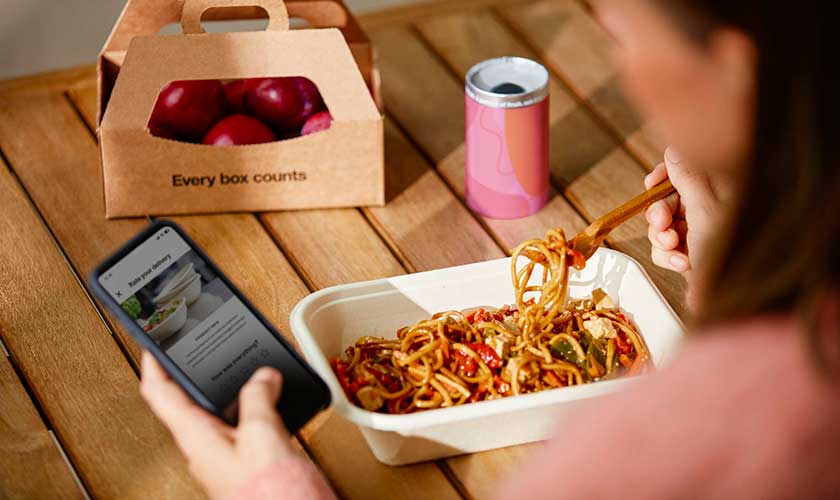In the eye of the storm
When it comes to packaging, consumers and legislators are all saying what the world needs to hear: “We want solutions that aren’t going to ruin the ocean or pollute the air. We want eco-friendly packaging. And we want it now.”
At Stora Enso, we couldn’t agree more, which is why we’re committed to leading the transition to fiber-based packaging and solutions that are renewable by nature and circular by design. They should be recyclable or biodegrable. The challenges are big. And the scale and speed at which solutions need to be implemented are unprecedented. But for us, there’s calm in the eye of the storm as we work across the entire value chain to change how the world packages everything from produce and on-the-go meals to online clothes and toilet paper – all with renewable materials.
We call it the eco-evolution. But if you look a bit closer, you might say it’s more like a revolution.
An eco-revolution
As Senior VP of Innovation and R&D Packaging Materials, my team and I are on the forefront of the transition to fiber-based packaging. It’s our job to develop new sustainable solutions that cut CO2 and are circular and recyclable – all while ensuring product safety and functionality.
Until recently, introducing a new packaging solution to the market used to take anywhere from 2 to 7 years from idea to roll-out. That’s mostly because of the safety requirements and regulations around food safety and production and reproducibility trials. Now, that process has to be much faster because of the pace set by consumers, brands and lawmakers. We also have to balance new requirements and, for example, shorten the shelf life that packaging offers, where it makes sense.
Two years ago, for example, no one would have even thought about eliminating pure plastic straws, and now they’re a thing of the past. The transition is happening fast. In my opinion, having the ability to change what’s used as packaging material at such a fast and vast pace isn’t an evolution, it’s a revolution.

Designing for the planet and people
The need to replace as much plastic and other fossil-heavy packaging with renewable and eco-friendly fiber options is clear. But finding the best solutions for the planet, brands and people isn’t always as simple.
If the goal is to protect our oceans, seas and marine life, the simplest and fastest answer is to get rid of plastic, because that’s where a lot of it ends up. To do that, we can either switch to solutions that are biodegradable and dissolve in water. Or we can make things that are recyclable. Both ideas solve the problem. The big question is which is better?
For me, this question is key. And there’s a lot of discussion happening now around trying to find common ground when it comes to answering it. One of the best tools to do that is Life-Cycle Assessment (LCA), which is essentially the determination of a package’s impact on the environment over the course of its lifetime.
If you look at performance alone, plastic is tough to beat. It’s gas-tight and water-tight, which is why it’s so good at keeping food fresh. And that’s also exactly why it doesn’t degrade. Fiber-based packaging, on the other hand, is biodegradable, but it can’t preserve food as well as plastic. That means food has a lower shelf life and more of it is wasted in the value chain. Focusing more on improving recyclability allows you to retain high performance and waste less. But the recycling process means investing more time, energy and water.
Standards around LCA needed
Creating globally accepted standards around LCA would greatly help teams like ours and the industry in general to quickly and effectively benchmark which solutions have the smallest impact on our environment.
There are already some obvious cases. Plastic straws are notorious for being littered and 99% of people don’t care about making a detour to the bin to recycle them. So banning them made sense for lawmakers. Another example is non-reusable cutlery and plates, which used to be made of plastic such as Styrofoam and are now mostly made of paper. In this case, paper is clearly a better option. And reusable designs for single-use products clearly aren’t the best option either. That’s because when people are using single-use products, they generally either can’t or don’t want to wash them. So designing fiber-based options clearly makes the most sense (Read the article about QSR LCA study).
Legacy or habit products like these, which have been around for decades, are now quickly getting cleaned off the table, which is good for the environment and for people. And there are lots of other applications that are under life cycle assessment right now, too. For some of them, we’ll find that paper is a better option. For others, it won’t be.
The journey continues
The direction is clear – consumers, brands, governments and the entire planet need sustainable solutions. Legislation has taken on the obvious ones. Going forward, I anticipate an awakening on the horizon, where less plastic is used and fiber takes over. But for that to happen, we need lots of good discussions and consensus around what works and what doesn’t. One thing is for sure: packaging has the potential to become a hero product when it comes to innovative sustainable design.






